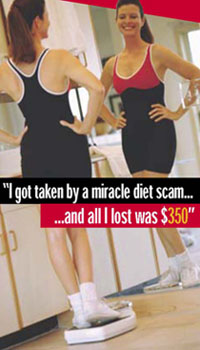Why You Shouldn't Believe
Before And After Photosby Tina Juan -
Tinajuanfitness.info
Last year, the United States Federal Trade
Commission (FTC) released a report that studied 300 weight loss ads and found
that 40 percent of them made at least one false representation and 55 percent
of them had at least one unsubstantiated claim.

The FTC noted that testimonials and
before-and-after photos were commonly used in the ads but "rarely portrayed
realistic weight loss."
The FTC report stated, "False or misleading
claims are common in weight-loss advertising, and based on our comparison of
1992 magazine ads with magazine ads for 2001, the number of products and the
amount of advertising, much of it deceptive, appears to have increased
dramatically over the last decade."
The ads that were studied were found not
just in TV infomercials and cheap tabloids but also in reliable mainstream
newspapers and magazines.
The FTC said that lack of media screening in
accepting ads for weight loss gives the products credibility and makes it
harder for the public to discern what is true and what is not.
An ordinary person believes that if a
trustworthy newspaper or magazine is allowing the ad to be printed, then the
claims must be true. Unfortunately, this is not always so.
In the FTC press release, chairman Timothy
J. Muris said, "We have known for some time now that there is a serious problem
with weight-loss product advertising. This report demonstrates the extent of
that problem."
He also said, "Reputable marketers continue
to take care to avoid false and misleading claims, but it appears that too many
unscrupulous marketers are making false claims promising dramatic and
effortless weight loss to sell their products.
"It is not fair to consumers; it is not fair
to legitimate businesses, it is illegal, and it will not be tolerated."
Those are fighting words, and while I don't
mean to put down the valiant efforts of the FTC to rid the market of unethical
advertising practices, the reality is that the FTC has its hands full trying to
go after companies making false health and fitness claims because no matter how
many they close down, two or three more spring up in place.
The agency has been able to force some big
companies who have made false claims to refund their customers (a recent
example is the maker of Fat Trapper and Exercise in a Bottle) but they don't
have enough manpower and resources to go after the majority of dishonest
marketers of weight-loss products.
The only way for the public to be protected
is through education. Consumers who are wise to the deceptive practices of
weight-loss ads will hopefully have enough discernment to recognize a fake when
they see one.
Here are some of the ways advertisers can
mislead you with before-and-after photos.
The crudest method is using two different
people – a fat out-of-shape person for the "before" and a slim fit person
for the "after."
The ads don't claim that they are the same
person but the implication is that if you look like the before picture, you can
look like the after picture if you use their product. This is misleading
because people in the pictures may have different body types.
A short, stocky person cannot look like a
long willowy fashion model even if he or she loses weight and gets fit.
But since many consumers are not educated
enough or realistic enough to realize that no amount of exercise, diet, or
taking of a weight-loss product will change their body to look like that of
someone else, there will always be people who will fall for this old trick.
Remember that you can become a
better-looking and better-functioning version of yourself but you cannot become
someone else.
Other methods use the same person for the
before and after pictures but twist the truth.
One ploy is claiming the results were
achieved in a much shorter period of time than how it really happened.
For example, the ad might say, "You can have
rock-hard abs in just three weeks" when the truth is it took the person in the
pictures years to achieve that look. Additionally, the person may not even have
used the product but has allowed his or her picture to be used (for a generous
fee, of course) to imply that.
It is much easier to make a fit body look
unfit than to do it the other way around. So, a common practice is to pay a fit
person to gain weight (imagine being paid to eat all the pizza and ice cream
you want), wait for a couple of weeks, then take a picture and use that
photograph as the "before." Then wait again as the person gets back in shape
and take the "after" picture.
You might be thinking at this point,
wouldn't it be easier just to pay customers who are using the product to
endorse it and give their before-and-after pictures?
Yes, it would be easier if you really had
customers who had spectacular results in terms of looks and how long it took to
achieve. That's just the point. Many of these products don't work, or if they
do, they don't work as well or as fast as they say they do. That's why they
resort to misleading methods like the one just mentioned.
When it comes to selling muscle supplements,
bodybuilders are sometimes hired as models and instructed to stop taking
steroids and refrain from working out.
When they have lost enough muscle to look
puny and flabby, the "before" picture is taken. A few months after going back
on steroids and training hard, they are ready for the "after" picture.
This is according to Bob Whelan, author of
the article "The Bodybuilding Disgrace" that was posted on
www.naturalstrength.com. Whelan also says that for added drama and "proof" that
the product being advertised is effective, the model is sometimes photographed
holding a newspaper headline.
Here's a real-life example of how a major
weight loss supplement company allegedly manipulated before and after pictures
for its ads.
Cytodyne, makers of Xenadrine, a popular
"fat-burning" supplement, is being sued by Jason Park, a La Jolla, California
resident, for falsely claiming that its product is safe and effective and for
using misleading before-and-after pictures.
Last month, Penni Crabtree, a writer for The
San Diego Union-Tribune, reported on some of the details of the ongoing trial.
She wrote that Mike Piacentino of Los
Angeles was one of the customer testimonials used in a Xenadrine ad, which
stated that Piacentino was able to lose 46 pounds of fat in 10 weeks while
putting on 12 pounds of lean muscle mass because of the product's "incredible
fat burning power." But in a signed declaration, Piacentino, a bodybuilding
competitor, said he was paid by a Cytodyne employee to stop working out and
gain as much weight as possible in three weeks after which the "before" picture
would be taken.
Piacentino further stated in his declaration
that on the day of the picture taking, he was instructed to wear long baggy
pants to hide his muscular legs and tie up the drawstring pants below his
stomach to make it look like he had a "hanging gut." He was also told to stand
in a slouched posture, distend his abdomen, and frown.
According to Piacentino, Cytodyne then
supplied him with Xenadrine as well as other supplements, which he took for
14-16 weeks. He said that one week before the "after" photo was supposed to be
shot, he was told to take a diuretic to lose as much water weight as possible.
Piacentino stated that his pictures were
false for several reasons: He did not just take Xenadrine as the ad implied but
he took numerous supplements. It took him 16 weeks to lose weight, not 10 weeks
as stated in the ad. And finally, Xenadrine did not make him develop 12 pounds
of lean muscle because he had already had it from years of working out.
Crabtree wrote that Piacentino is now being
sued by Cytodyne for defamation and breach of contract. Piacentino's lawyer,
meanwhile, has submitted his client's affidavit to the Department of Justice
and is asking for an investigation because of the alleged witness tampering and
intimidation by Cytodyne.
Actually, marketers of weight-loss and
muscle-building supplements don't even have to go as far as Piacentino claims
he was instructed to do because with the right lighting and posing, a good
photographer and skilled bodybuilder can produce a weight loss "miracle" in a
couple of minutes.
TC Luoma writes a weekly column called "The
Atomic Dog" for Testosterone Magazine.
In the online version, www.t-mag.com, he
features a visual example of how bodybuilder Davin Ramatour goes from fat to
fab in just five minutes (the length of time it took to change his shorts and
for the crew to change the lighting and background, according to Luoma).
If you want to see this amazing
transformation for yourself, go to www.t-mag.com/nation_articles/227tc.html.
You may never look at another before-and-after picture in a muscle magazine the
same way again.
Not all before-and-after pictures are
dishonest. Dermatologists and cosmetic surgeons use photographs to keep a
documented record of their work.
But these photographs have to be taken under
the same conditions each time (angle, lighting, lens exposure, etc.) to be
accurate. Unfortunately, in today's digital age, it is so easy to alter a
photograph. The only way to be really sure is to put your trust in the ethics
and integrity of the doctor or company involved.
Just for fun and to see examples of how
digital artists can convincingly change a slim person into a fat one, go to
www.fatlaneonline.com. This strange site gets its kicks from turning slim
celebrities like Britney Spears and Ashley Judd into heftier versions of
themselves.
The pictures with subtle changes (10-20
pounds added) look very realistic. The ones that try to make Calista Flockhart
look like "the fat lady" in the circus end up looking a little fake. Like I
said, it's a strange site.
There are even several tutorials that give
you step-by-step instructions on how to make your friends (or enemies) look
like they have gained weight. It is logical to assume that by using opposite
techniques, you can doctor the picture of a fat person to look like they have
lost weight.
In closing, be smart and remember always
that it is a "caveat emptor" or "buyer beware" market when it comes to
weight-loss and muscle-gaining supplements.
About Tina Juan
 TINA JUAN is a
certified fitness professional by the American Council on Exercise and the
American College of Sports Medicine. She teaches group exercise, strength
training, Pilates, and yoga. She co-founded and developed the Association of
Fitness Professionals of the Philippines (now called Fitness Philippines
Network), a 16-year old non-profit organization devoted to continuing education
for fitness professionals. TINA JUAN is a
certified fitness professional by the American Council on Exercise and the
American College of Sports Medicine. She teaches group exercise, strength
training, Pilates, and yoga. She co-founded and developed the Association of
Fitness Professionals of the Philippines (now called Fitness Philippines
Network), a 16-year old non-profit organization devoted to continuing education
for fitness professionals.
She educates the public through her website,
weekly newspaper column, monthly magazine columns, and fitness show. She is a
resource speaker for medical conventions and post-graduate courses, corporate
wellness programs, and civic groups. www.TinaJuanFitness.info |